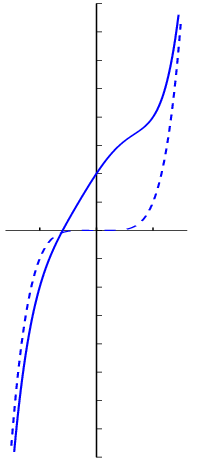Basic functions: Polynomial functions
 Three properties of polynomial functions
Three properties of polynomial functions
The function \(f(x) = x^3 - 1\) is an example of a third degree function in \(x\) with leading term \(x^3\). This polynomial can be written differently: \[x^3-1 = (x-1)(x^2+x+1)\] Check this by expanding brackets. The factor \(x-1\) does not come completely out of the blue, but is a consequence of the fact that \(x=1\) is a root of the polynomial, i.e., \(f(1)=0\). More generally, the following factor theorem holds:
Factor theorem If \(f(x)\) a polynomial of degree \(n\geq 1\), and \(a\) a real number for which \(f(a)=0\), then there is a polynomial \(g(x)\) of grade \(n-1\) such that \(f(x)=(x-a)\cdot g(x)\) .
We do not discuss here the method of finding such a polynomial function \(g(x)\) given a factor \(x-a\), except that we tell you that it works with the so-called long division of polynomials (similar to long division with numbers) and that in simple cases the polynomial function \(g(x)\) can be computed by a direct method..
We consider the cubic polynomial\(x^3-7x-6\).
By looking carefully at the polynomial it can be noted that \(x=-1\) is a root of the polynomial. This means that \(x+1\) is a factor of the factorisation of the cubic polynomial and that \[x^3-7x-6=(x+1) (ax^2+bx+c)\] for some numbers \(a\), \(b\) and \(c\). Removal of brackets in the right-hand side and collection of terms gives \[x^3-7x-6=ax^3+(a+b)x^2+(b+c)x+c\] Now we compare the coefficients of like terms on the left- and right-hand side annd find that \[a=1,\quad a+b=0,\quad b+c=-7,\quad c=-6\] In other words: \[a=1,\quad b=-1,\quad c=-6\] So: \[x^3-7x-6=(x+1)(x^2-x-6)\] By inspection we can factorise further: \[x^3-7x-6=(x+1)(x-3)(x+2)\] The roots of the cubic polynomial \(x^3-7x-6\) are therefore \(x=-1\), \(x=3\) and \(x=-2\).
\(\phantom{x}\)
A second important property of a polynomial function concerns factorisation with real coefficients. For this purpose we first note that a polynomial \(p\) is irreducble if its degree is greater than 0 is and the polynomial cannot be written as a multiple of polynomials with lower nonzero degree, i.e., if the only divisors of \(p\) are constants and constant multiples of \(p\).
Factorisation of polynomials with real coefficients Every polynomial can be factorized using only real numbers as coefficients as a product of linear and irreducible quadratic polynomials. This factorisation is unique up to a scalar and the ordering of the factors.
The factorisation of the polynomial \(x^6+x^4-x^2-1\) is up to ordering of factors equal to \((x-1)(x+1)(x^2+1)^2\).
\(\phantom{x}\)
A third important property of a polynomial function concerns asymptotic behaviour:
Asymptotics Consider the polynomial \[f(x)=a_nx^n+a_{n-1}x^{n-1} + \cdots + a_2x^2+a_1x+a_0\] with \(a_n\neq 0\). For large values of \(x\), the function value \(f(x)\) is almost completely determined by the value of the leading term \(a_nx^n\).
In the above example of \(f(x)=x^3-1\) is \(f(1000)=(1000)^3-1=999999999\approx 1\,000\,000\,000=1000^3\) .
More generally: For large \(x\), the sign of \(f(x)=a_nx^n+a_{n-1}x^{n-1} + \cdots + a_2x^2+a_1x+a_0\) is equal to the sign of the leading term \(a_nx^n\) and depends on
- the sign of \(x\) (positive or negative),
- the sign of \(a_n\), and
- oddness or evenness of \(n\) (After all, if \(x\) is a negative number, then \(x^n\) is negative if \(n\) is odd and positive for even \(n\)).
In the figure below, the graph of the fifth degree polynomial function \[f(x)=x^5-x^3-x^2+3x+2\] and the graph (dotted line) of the power function \[g(x)=x^5\] are plotted over the interval \((-1.6,1.6)\). For the sake of clarity the horizontal axis is scaled differently than the vertical axis.
What you see is that the two graphs already come too close together when \(|x|\approx 1.6\). In general, \(f(x)\approx g(x)\) for large \(x\). In other words, \[x^5-x^3-x^2+3x+2\approx x^5, \mathrm{\;for\;large\;values\;of\;}x.\]

Mathcentre videos
Solving Cubic Equations (21:31)
#\phantom{x}#
Polynomial Division (13:57)


